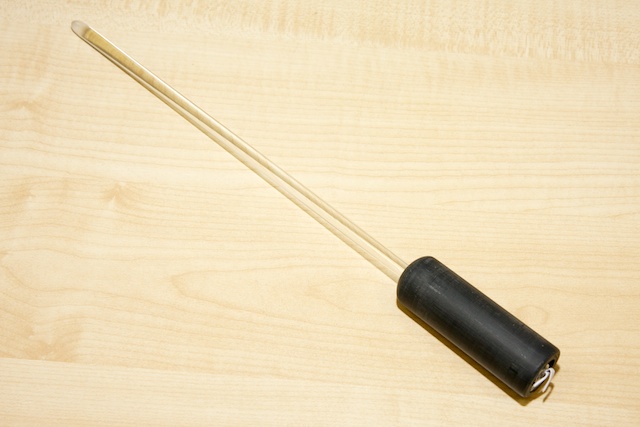The Bookla! Tracker
Buchla units provide their data at a rate of only around 100 samples per second. They are also very hard to get; they have technical stability issues, such as requiring very "clean" power supplies and special connector cables between tracker head and base unit; and they can do much more than what we need. On the other hand, the concept of analog tracking of an active infrared light source is still unbeaten for conducting scenarios - all camera-based techniques max out at 60-200 fps, and often introduce significant latency through the digital high-resolution image processing required; and all passive-reflection techniques such as the OptiTrack system fail in our typical settings, where exhibit visitors can wear all sorts of reflective material in clothing and accessories.
Can we design our own infrared receiver that uses analog tracking of an infrared source, but that is built around modern digital techniques, such as a DSP plus microcontroller, and that delivers just 2d tracking data for one baton, but at much higher sampling rates (in the kHz range) when needed?
For our analog sensor, we bought
- 4 photodiodes (10x10mm, 1mA max current, Advanced Photonix PDB-C613-2, DigiKey PDB-C613-2-ND, around 25 € each)
- 4 dual op amps (rail-to-rail, SOIC packaging, Linear Technologies LT6221, DigiKey LT6221CS8#PBF-ND, a few € each)
Data Sheets, etc.
- National Semiconductor presentation about photodiode amplifiers from David Peters (PDF)
- The seminar transcript explaining the above slides in more detail (PDF)
- The reverse engineered head unit layout
The Bookla! Baton v3.0

The Bookla! batons are a redesign of Don Buchla's Lightning III batons, as used in our Personal Orchestra exhibits.
Parts List:
Battery: Conrad CR123 Lithium Battery (3.7 V, 650 mAh)
Microcontroller: ATtiny44A (16bit counter, low power consumption)
Motion sensor: Sensolute
Casing: Custom design by Niklas Hauser from our group
Basic Pulse Signal
Each baton emits a square wave of infrared light, at 12.8 kHz for the red (left) baton and 16.0 kHz for the green (right) baton. For conducting, we need only one baton. We decided to use the frequency of the red baton.
Our experiments have shown that the duty cycle is uncritical—only the frequency is interpreted by the Buchla Lightning III receiver. The simplest approach therefore is to use a square wave with 12.8 kHz, or a period of 1/12.8 kHz = 78 µs with a 50% duty cycle (39 µs high, 39 µs low).
However, for increased mechanical robustness, we use just one LED attached directly to the grip of the baton, instead of several LEDs in the baton tip. To still reach the same momentary brightness as the original batons with their with their four LEDs in the tip, we shorten the duty cycle of our LED to around 13%, which lets us drive it at a higher current.
The resulting square wave has a 10 µs high phase, followed by a 39+(39-10) = 68 µs low phase. The LED is thus on during 12800 * 0.00001 = 0.128 ms per second.
LED Setup
Our first experiment used a Kingbright LED pulsed with 100 mA. Results for the front view were quite good, but from the side, the resulting brightness was still insufficient.
Motion Detection Power Management
Each of our batons also includes a motion sensor. If the batons rest for a certain period of time, the baton turns off the infrared LED to conserve power, resulting in longer standby times. This way, our batons last through a typical 10-hour museum day on a single charge.
Power Supply
The Lithium cell we use is smaller than the standard AA battery used in the Buchla baton. At the same time, it delivers 3.7 V, which is enough to run our microcontroller and LED without the need for a voltage step-up converter as required in the original Buchla batons.
Casing and Construction
We designed a 3D model for our hand grip that we print on our 3D ABS printer. The hand grip contains all the electronics and a standard barrel plug socket to plug in a Lithium battery charger. The acrylic shaft is attached to the hand grip with acrylic glue (toxic). The end tip of the shaft is tapered, drilled and sanded in a special way to distribute the light to the sides as well as the front.

